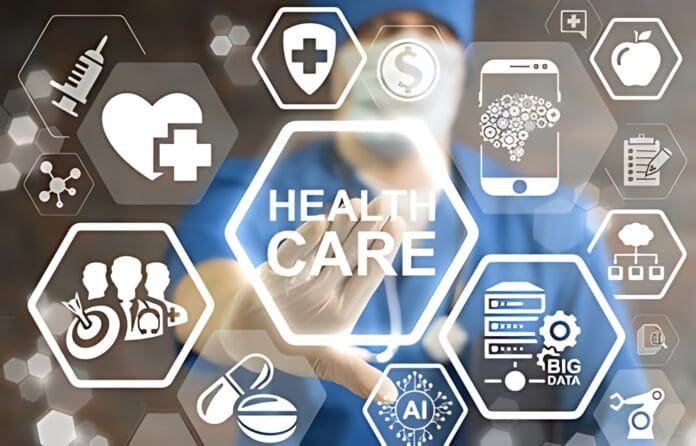Introduction
AI is becoming more important in healthcare because it can improve patient care, the accuracy of diagnoses, and the results of treatments. AI makes administrative chores easier, telemedicine better, and treatment plans more personalized. It speeds up the search for new drugs, helps mental health, and strengthens data protection. AI’s predictive analytics helps with disease control and public health. This will eventually change how healthcare is provided and improve it for all patients.
The power of AI in improving patient care and wellness.
Early and Correct Diagnoses: AI can look at a massive amount of medical data, like X-rays and patient information, to find diseases and conditions early on. This means that assessments are made faster and more accurately, improving treatment results.
Personalized Treatment: AI uses information about each patient to make treatment plans that are just right for them. AI ensures that therapies work better and have fewer side effects by considering each person’s genes, medical background, and way of life.
Better telemedicine: AI platforms can give remote consultations and monitoring. This is especially important in rural or underserved places where it’s hard to get medical care.
Chronic Disease Management: Wearable gadgets that AI powers monitor people with long-term illnesses and send real-time health information. This makes it possible for proactive control, which lowers the number of hospital stays and raises patients’ quality of life.
Drug Discovery: AI speeds up drug discovery by modeling how chemicals interact, guessing which molecules might be suitable drug candidates, and finding molecules that could be used to treat illness. This makes it faster for new treatments to be made.
Clinical Decision Support: AI gives healthcare workers insights based on evidence, which helps them make better decisions. It cuts down on wrong diagnoses and makes treatment plans better.
Predictive analytics: AI processes and analyzes data to find disease areas, predict disease outbreaks, and look at health trends across populations. This backs up public health efforts and getting help early.
Support for Mental Health: Virtual advisers and chatbots that AI runs can immediately help people with mental health problems and give them access to resources. This meets the growing need for help with mental health.
Administrative Efficiency: AI automates administrative jobs, which cuts down on paperwork and makes things run more smoothly. This gives healthcare workers more time to care for patients.
Data Security and Privacy: AI improves data security, keeping patient information safe from hackers and ensuring that healthcare rules are followed.
Disease Modeling and Simulation: AI models show how diseases spread and what happens when different actions are taken. Policymakers and people who work in healthcare can try out tactics and make intelligent choices.
Engaging Patients: Chatbots and virtual helpers powered by AI interact with patients by giving them information, answering their questions, and reminding them to take their medications. This helps patients understand their health better and follow their treatment plans better.
Quality of Care: AI encourages care based on data and clinical best practices. Based on the most recent research and guidelines, helps healthcare professionals make better choices.
Public Health Measures: AI helps people make decisions about public health by looking at data and figuring out how health policies and actions work. This lets changes be made quickly and problems with general health be handled well.
The most important thing AI can do for healthcare is make care more accurate, personalized, and available while making processes run more smoothly. It could change how healthcare is provided, putting the patient first and leading to better health results. Here is a tedxtalk about AI in Healthcare you can check out the video.
II. The Role of AI in Diagnostics
Artificial intelligence (AI) dramatically affects medical diagnostics, changing how doctors find and identify diseases. AI algorithms’ ability to analyze medical imaging data, which allows for early and accurate disease discovery, is a big reason for these giant steps forward.
- Seeking out and analyzing patterns: A huge amount of medical imaging data is used to teach AI algorithms. Deep learning methods allow These algorithms to find patterns, irregularities, and image changes that point to possible health problems. This skill is especially useful for finding early signs of issues that might be hard for human eyes to see.
- Finding Anomalies: AI finds strange things in medical pictures very well. These programs can find possible signs of disease, like a small bump on an MRI or a slight change in tissue density on a CT scan. This helps see conditions early.
- More accuracy and efficiency: AI lowers the chance of making a mistake in medical diagnosis, cutting down on false negatives (missing a disease) and false positives (diagnosing the wrong illness). This accuracy not only helps doctors make better decisions but also makes the best use of healthcare resources.
- Speed and Timely Diagnosis: Diagnostic tools that AI powers give quick results, which greatly speeds up the diagnosis process. This speed is very important, especially in emergencies or cases where getting early help can significantly affect how well the treatment works.
- Consistency and Reliability: AI ensures that the research level is always the same, so different doctors don’t have to make as many guesses about what the results mean. This standardization makes diagnoses more reliable, regardless of which doctor makes them.
- Learning and getting better: AI models keep improving as they look at more data and learn from it. Over time, this continuous learning process makes people more accurate and better able to spot more subtle trends.
- Integration of telemedicine: AI is a big part of telemedicine because it lets doctors diagnose patients from afar. This feature makes healthcare available in places that are hard to reach or don’t get enough of it, making early detection and disease monitoring easier.
- Help with clinical decisions: AI helps healthcare workers make decisions by giving them relevant data, insights, and suggestions. This helps make it easier for doctors to make better decisions about their patient’s care, which allows them to diagnose and treat them.

Overall, AI significantly affects medical diagnostics because it can improve speed, accuracy, and stability while finding diseases earlier. This transformative power enhances patient care, speeds up diagnostic processes, and gives doctors and nurses the tools they need to make better, more timely choices that lead to better patient health outcomes.
III. Personalized Medicine and Treatment
“AI is transforming healthcare by focusing on personalized health management.
It’s not one-size-fits-all but tailored solutions for every patient.”
(Mark Zuckerberg on X)
AI’s role in tailoring personalized treatment plans:
AI is a key part of making treatment plans specific to each patient based on their genetics and medical history. This makes healthcare more personalized and efficient. Here’s how AI does this and some examples of how it predicts how a cure will work to cut down on trial and error:
Making genetic profiles: AI can look at a patient’s genetic information to find specific genetic differences that might change how they react to different treatments. It is used to make treatment plans more specific and choose methods more likely to work for that person.
Analysis of the medical history: AI algorithms can look at a patient’s medical background, which includes illnesses, treatments, and how they responded to medications in the past. AI can find treatment choices that have worked in the past for patients with similar profiles by comparing this data to a huge database of patient outcomes.
Evaluation of Drug-to-Drug Interactions: AI checks to see how different drugs might combine. This ensures that a patient’s treatment plan considers the medicines they are already on, which lowers the risk of side effects.

Examples of Guessing How a Treatment Will Work:
Oncology and Treatment for Cancer: AI looks at genetic information to guess how a certain cancer patient will react to different types of treatment. AI reduces the need for trial-and-error methods by determining the best treatment for each patient based on their genetic background. This improves the overall success of cancer treatment.
Choosing Psychiatric Drugs: AI can look at a person’s genetic information and medical background to determine which psychiatric drugs are most likely to work and cause the fewest side effects. This customization improves mental health care and makes it less frustrating to try different medicines until you find the right one.
Choosing an antibiotic: AI can guess which antibiotics will work best on bacterial infections by looking at the patient’s medical background, the type of bacteria that caused the infection, and already known antibiotic resistance patterns. This keeps people from getting medicines that don’t work and stops antibiotic resistance from happening.
Accurate Medicine in Cardiology: AI looks at a patient’s genetic information to figure out the best medicines and doses for health problems like high blood pressure and heart disease. This method helps patients do better and has fewer side effects.
Diabetes Management: AI tracks a diabetic’s blood sugar levels and insulin reaction to determine the best insulin doses. This reduces the need for manual adjustments and improves blood sugar control.
Treatment for autoimmunity diseases: AI looks at a person’s genetics and experience of autoimmune diseases to suggest immunosuppressants that are more likely to work and have fewer side effects.

In all these cases, AI suggests how a treatment will work by looking at the patient’s genetic and medical traits. This reduces the need for trial-and-error, which can cause harmful side effects and a longer recovery time. This personalized treatment method is a faster and better way to provide healthcare, leading to better patient care and outcomes.
IV. Telemedicine and Remote Healthcare
AI-powered telemedicine platforms are a big part of making healthcare available in remote or underserved areas. They also have a lot of benefits for patients who want to get better access to medical knowledge, such as:
- Accessibility based on location:
AI-powered telemedicine lets people in rural or poor areas get medical care without traveling a long way. In rural or remote areas where healthcare services are limited, this is especially important for people who live there.
- Quick access to medical care:
Patients can get instant medical advice through telemedicine. This can be very important in emergencies and situations where help is needed immediately, ensuring that people get the care they need when needed.
- Consultations with specialists:
Telemedicine lets people in remote places talk to doctors and specialists who might not be in the same room. Experts in many areas, such as neurology, cardiology, and dermatology, can meet with patients.
- Taking care of chronic diseases:
Patients with long-term illnesses can benefit from follow-up visits and constant remote monitoring. This makes it easier to care for people with chronic diseases and ensures they get the same care every time.
- Savings on costs:
Patients who use telemedicine to get care save money on travel costs and the time and trouble that comes with it. This is especially helpful for people who live in remote places where getting around can be hard and expensive.
- Privacy and ease of use:
Patients can get medical care without leaving their homes, which removes some of the stress and anxiety that comes with going to a healthcare center. This can be especially helpful for people who have trouble moving around or who have anxiety conditions.
- Care for prevention:
Telemedicine helps preventative care by making it possible to get regular check-ups and find health problems early. This can help people get help earlier, which can lessen the severity of conditions and improve health results.
- Care Based on Data:
AI can constantly watch and analyze data about patients, giving healthcare workers feedback and alerts in real-time. This method is based on data, which improves the quality of care and helps patients get help sooner.
- Dealing with gaps:
Telemedicine helps deal with healthcare gaps by ensuring that people in underserved areas get the same level of care and access to experts as people living in cities.
- Controlling the Epidemic:
Telemedicine helps spread public health by letting people in rural areas find and treat diseases early on. Telemedicine is a helpful way to monitor and manage healthcare on a bigger scale during outbreaks or pandemics.

In conclusion, AI-powered telemedicine systems are changing how easy it is to get medical care, especially for people who live in remote or underserved areas. Telemedicine improves patients’ access to high-quality healthcare by removing geographical barriers, giving care quickly, and supporting continuity of care. It also makes medical consultations more cost-effective and convenient.
V. Chronic Disease Management
AI-powered wearable devices
Wearable AI-powered devices help people with chronic conditions by constantly checking vital signs, giving personalized insights, reminding people to take their medications, tracking their activities, allowing online monitoring, sharing data with healthcare providers, and improving their quality of life. Built-in sensors in these gadgets track things like heart rate, blood pressure, exercise levels, and more. This real-time data is looked at by AI programs to find trends and outliers.
Wearable devices driven by AI are beneficial for managing long-term conditions because they keep track of vital signs and send real-time data to healthcare providers. Here is a description of how these devices work and how they can help with managing chronic diseases.

Continuous Monitoring: Wearable tech has sensors that collect information about your heart rate, blood pressure, blood sugar levels, breathing rate, and level of exercise all the time.
Data Collection: Over time, the devices gather much information about the person who wears them, which is used to make a complete health picture. This data includes details about daily habits, sleep patterns, and exercise levels.
Real-Time Analysis: The AI algorithms built into the devices look at the data they receive in real-time. They look for patterns, trends, and outliers, which lets doctors find changes in health state early on.
Patient Engagement: Apps and tools for wearable tech that give people information about their health are often easy to use. They provide personalized advice on how to change your lifestyle when to take your medications, and other health-related help.
AI Analysis: The data is run through AI algorithms that look for changes or trends that could point to a health problem. One sign of cardiac arrhythmia could be a quick rise in heart rate.
Alerts and Notifications: If the AI finds a worrying trend or oddity, it can alert the person wearing it or their healthcare provider. These alerts might make you do something immediately, like call a doctor.
Sharing Data: If the user agrees, the data can be sent safely to healthcare workers so that they can check on the patient’s health from afar. This sharing is beneficial for managing long-term illnesses and giving care after surgery.

Advantages of wearable tech in managing chronic conditions:
Early Intervention: These devices let you notice changes in your health early so you can get medical help immediately for long-term problems.
Personalized Care: AI can make suggestions based on information about a person, making customized care plans to help them deal with their situation.
Better Adherence: Reminding patients to take their medications and keeping track of their activities can help them stick to their treatment plans.
Remote Monitoring: Doctors and nurses can check their patients’ health from afar, so they don’t have to see them as often.
Better Quality of Life: Wearable devices give patients the power to take charge of their health by giving them real-time info and insights. This makes their quality of life better overall.
Cost Savings: By cutting hospital stays and emergency room trips, remote tracking and early intervention can help healthcare systems save money.
Wearable AI-powered devices are becoming very useful for managing chronic diseases. They offer a proactive, data-driven method that is good for patients and healthcare providers.
VI. Drug Discovery and Development
AI speeds up the process of finding new drugs by modeling chemical interactions and finding possible drug candidates in the following ways:

- Virtual screening: AI can virtually screen huge collections of chemical compounds to guess how they might react with specific proteins or molecules linked to diseases. This cuts down on the time and materials needed for trying experiments.
- Designing drugs-based molecule structure: AI looks at the three-dimensional shapes of molecules and proteins to create new drugs that target particular molecules. This makes drugs more specific and compelling.
- Predicting Pharmacokinetics: AI models can guess how drugs will be broken down and distributed in the body, which helps choose compounds with the best pharmacokinetic qualities.
- Toxicology Prediction: AI figures out how dangerous drug prospects might be, which helps focus research on making safer compounds.
- Drug Repurposing: AI finds old drugs that could be used in new ways to treat diseases, which speeds up the process of finding new medicines.

Real-Life Examples
InSilico Medicine: AI is used by this company to develop possible drugs for illnesses like cancer and fibrosis. They developed a potential treatment for idiopathic lung fibrosis and are now testing it in people.
Atomwise: Atomwise uses AI for virtual screening to find possible drugs for various illnesses quickly. Within a week, they found what might be a cure for Ebola.
DeepMind: AlphaFold AI from DeepMind predicted the 3D shapes of proteins, which changed how we think about biology. This has big effects on finding new drugs and making new ones.
BenevolentAI: This business looks at biological data with AI to find possible drugs for diseases like Parkinson’s and Amyotrophic Lateral Sclerosis (ALS).
In these real-life cases, AI has been very important in speeding up drug discovery by predicting drug candidates, designing molecules, and improving the drug development process. This has led to faster and more effective treatments for many diseases.
VII. The Future of AI in Healthcare
AI is being used increasingly in healthcare, and new studies and developments are paving the way for huge steps forward. Pay attention to these important areas:
“AI is opening doors to better healthcare for everyone.
Let’s continue to invest in technology that
saves lives and makes healthcare more accessible.”
(Michelle Obama on X)
Disease Prediction and Prevention:
- AI is being used to make models that can predict diseases like Alzheimer’s, diabetes, and heart disease. This lets early intervention and prevention methods be used.
- Wearable tech and health apps are always getting better so that they can track and measure your health in real-time.
Imaging and Diagnostics:
- AI systems for medical imaging are getting smarter, which helps find and diagnose diseases like cancer, broken bones, and neurological disorders.
- New developments in radiomics and radio-genomics use AI to get valuable data from medical pictures, which makes diagnosis more accurate.
Drug Discovery and Development:
- Platforms that use AI to find new drugs are finding possible drugs faster and more efficiently, which speeds up the process of making new treatments.
- Personalized medicine is improving, and drug regimens are now being made to fit each person’s genetic background.
Remote and Telehealth Services:
- Telemedicine and remote patient monitoring are improving so that people in remote places or during public health crises can get high-quality medical care.
- Chatbots and virtual health assistants driven by AI are making patients more involved and giving them health information and advice.
Electronic Health Records (EHRs):
- AI is improving EHR systems, which accelerates data entry and makes data more secure.
- Natural language processing (NLP) gets helpful information from patient data and unstructured clinical notes.
Genomics and Personalized Medicine:
- AI allows in-depth analysis of genomics data, which helps find genetic markers and possible medicines tailored to each patient.
- Pharmacogenomics is improving at using a person’s genes to determine how they will react to certain medicines.
AI Ethics and Regulation:
- There is much continuing research into AI’s ethical use in healthcare. This includes examining patient consent, data privacy, and bias.
- The groups regulating AI in healthcare are always changing to keep an eye on it and ensure that patients are safe and data is kept secure.
AI-Driven Public Health:
- AI tracks and predicts disease outbreaks so that public health problems can be dealt with quickly.
- New epidemiology models are helping us learn more about how contagious diseases spread.
In the healthcare field, ongoing research and new developments in AI could improve patient care, healthcare delivery more efficiently, and our ability to prevent, identify, and treat a wide range of medical conditions better.
VIII. Ethical Considerations
Incorporating AI in healthcare raises several ethical issues that must be carefully considered. Here are some of the major concerns:
- Privacy and Data Security:
- AI systems frequently require access to sensitive patient data, creating worries about the information’s privacy and security.
- Data breaches and unauthorized access to medical records are significant concerns. Identity theft, prejudice, and even blackmail might result from these breaches.
- Protecting patient data through strong encryption and secure storage is critical to data privacy.
- Fairness and Bias:
- AI algorithms can inherit biases from training data, potentially leading to unfair or discriminating outputs, particularly for disadvantaged populations.
- It is critical to ensure fairness and equity in AI healthcare applications to avoid biases that could harm patient care and outcomes.
- Patient Consent:
- Patients may sometimes need help comprehending how AI systems use their data, and acquiring informed consent for data exchange and analysis is a complicated issue.
- Liability and Accountability:
It can be difficult to determine guilt and liability when AI systems make mistakes or generate inaccurate diagnoses or treatment recommendations.
- Black Box Algorithms:
- Many AI models are considered “black boxes” because their decision-making processes are challenging to explain. Building trust requires ensuring transparency and explainability in AI-driven healthcare.
- norms and Compliance:
- Healthcare is a highly regulated business, and ensuring that AI applications adhere to existing models and standards can be difficult.
- Adherence to the Health Insurance Portability and Accountability Act (HIPAA) is critical in the United States for protecting patient information.
- Misuse and Security Risks:
- AI healthcare tools may be misused or exploited for fraud.
- Preventing nefarious behaviors requires protecting AI systems from cyberattacks and ensuring their integrity.
- Job Displacement:
- As AI becomes more widely used in healthcare, there may be worries about the displacement of particular healthcare jobs, posing economic and workforce issues.
Responsibilities of AI applications are:
- Ensuring AI systems are built and taught to be bias-free and fair.
- Put robust data protection mechanisms, such as encryption, access limits, and safe storage.
- Creating clear and transparent consent protocols to notify patients about their data usage.
- Emphasizing comprehensible AI and offering rationales for AI-generated suggestions.
- Ensuring Compliance and data security by adhering to relevant legislation, standards, and best practices.
IX. Conclusion
By providing personalized treatment plans, predictive analytics for disease trends, remote monitoring, faster diagnostics, drug discovery, data-driven insights, telehealth, health management, improved research, global health accessibility, cost efficiency, and support for public health initiatives, AI unifies technology and wellness in healthcare. In turn, this revolutionizes healthcare by making it more readily available, individualized, and effective, ultimately enhancing health outcomes and patient satisfaction.




